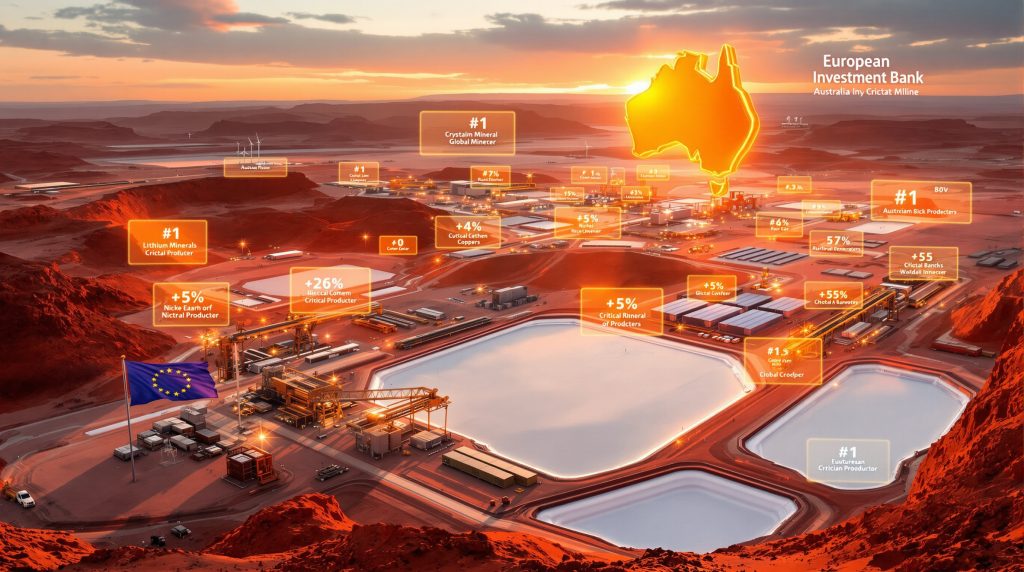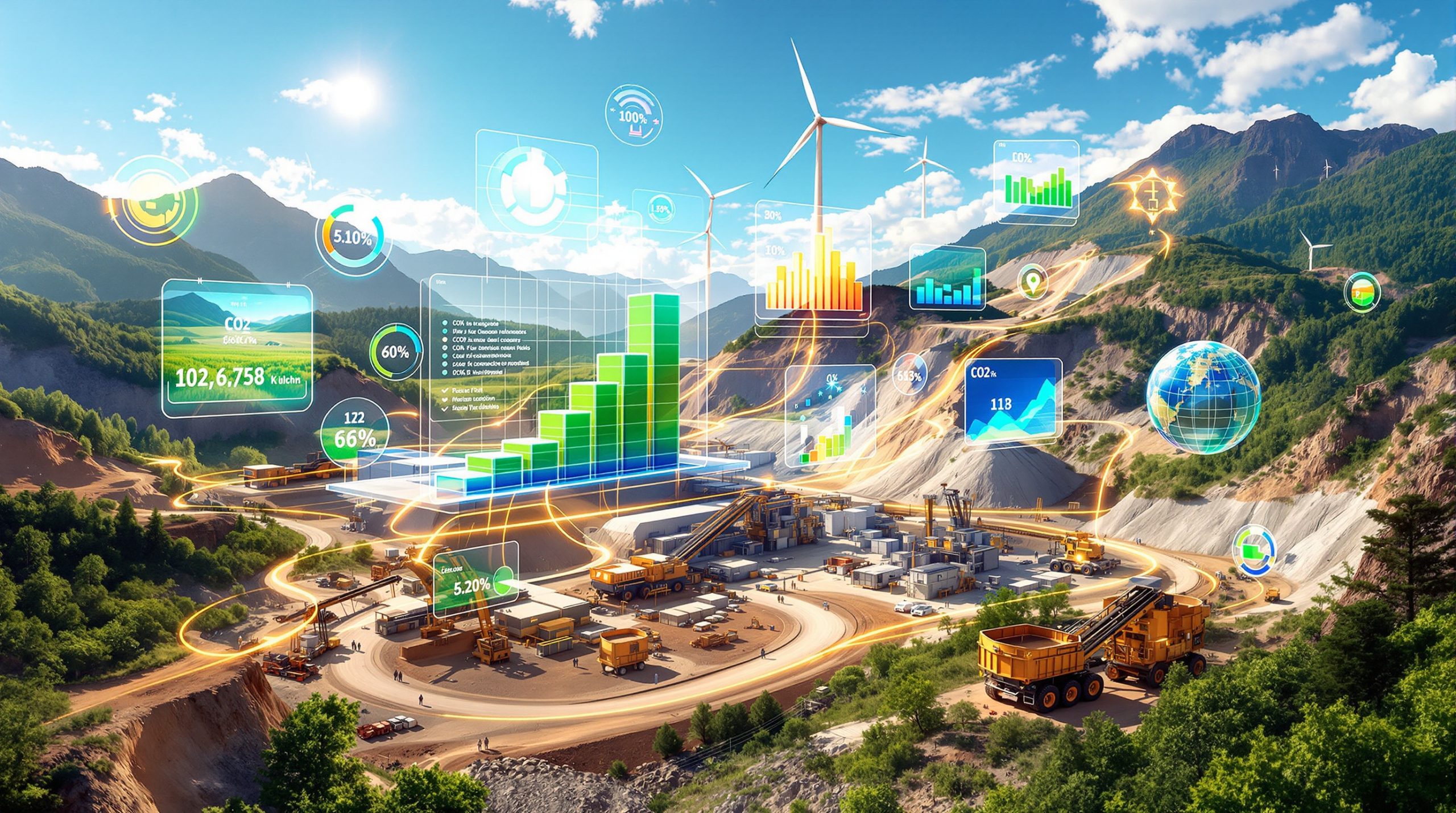European Investment Bank's Strategic Push into Australia's Critical Minerals Sector
The European Investment Bank has intensified its focus on securing critical mineral supplies through targeted investments in Australia, marking a significant shift in Europe's approach to resource security. This strategic initiative represents more than traditional trade relationships, establishing direct investment partnerships designed to strengthen supply chains for materials essential to critical minerals energy transition. The EIB seeking critical minerals investments in Australia reflects Europe's urgent need to diversify supply sources and reduce dependence on concentrated markets.
Australia's emergence as a priority destination stems from its unique combination of geological abundance, political stability, and established mining infrastructure. The nation's democratic governance framework provides the regulatory certainty that European investors require, while its century-long mining heritage offers proven operational capabilities essential for large-scale project development.
EIB Vice President Nicola Beer articulated this strategic approach at a Sydney mining conference, emphasising the institution's willingness to accept higher risk profiles and deploy capital efficiently for appropriate projects. This positioning distinguishes the EIB from conventional financial institutions and reflects Europe's urgent need to diversify critical mineral supply sources.
Risk-Taking Capacity Sets EIB Apart from Commercial Lenders
The European Investment Bank's approach to critical minerals financing differs fundamentally from traditional commercial banking models. With its AAA credit rating maintained across all major rating agencies as of 2024, the EIB seeking critical minerals investments in Australia can access capital markets at favourable rates while supporting higher-risk ventures that commercial banks typically avoid.
The institution's capital structure enables remarkable leverage efficiency, transforming every euro of capital into approximately 12-15 euros of lending capacity. This financial engineering capability far exceeds typical commercial bank ratios, allowing the EIB to support early-stage exploration projects and innovative extraction technologies that require patient capital.
Furthermore, Beer's emphasis on efficient capital deployment reflects the EIB's partnership-focused investment model. Rather than simple lending arrangements, the institution seeks collaborative relationships that combine European financial resources with Australian operational expertise and resource access. This approach creates value beyond traditional debt financing by fostering technology transfer and knowledge sharing between partners.
The EIB frequently employs blended finance structures, combining grants, loans, and equity investments to improve project bankability. This sophisticated financing approach makes previously unbankable projects viable by reducing overall risk profiles and improving returns for private sector partners.
Strategic Materials Driving European Investment Interest
Australia's dominance in critical minerals production creates compelling investment opportunities for European institutions seeking supply security. The country's lithium resources are particularly significant, with production of approximately 86,000 tonnes in 2023 representing 47% of global mine output. Australia's lithium reserves of 8.7 million tonnes constitute the world's largest known deposits.
| Critical Mineral | Australia's 2023 Production | Global Ranking | Strategic Importance |
|---|---|---|---|
| Lithium | 86,000 tonnes (content) | #1 globally | Battery production, energy storage |
| Rare Earth Elements | 18,000 tonnes (oxides) | #2 globally | Wind turbines, electric motors |
| Copper | 890,000 tonnes (refined) | #6 globally | Electrical infrastructure |
| Nickel | 180,000 tonnes | #4 globally | Battery cathodes, stainless steel |
The European Union's Critical Raw Materials Act, adopted in March 2024, establishes specific targets that underscore these materials' strategic importance. The legislation requires the EU to extract at least 10% of its annual consumption domestically, process at least 40% domestically, and ensure no more than 65% comes from any single third country by 2030.
In addition, rare earth elements present particular strategic significance, as China currently accounts for approximately 70% of global production and 90% of processing capacity. Australia's position as the second-largest producer, with established operations like Lynas Rare Earths' Mount Weld facility, offers European investors access to non-Chinese supply sources. This aligns perfectly with India's lithium strategy in diversifying supply chains among democratic partners.
Copper demand projections add urgency to investment decisions, with the International Energy Agency forecasting 50% demand growth by 2040 driven primarily by electrification and renewable energy infrastructure. Similarly, nickel demand for battery applications is expected to increase more than tenfold by 2030 compared to 2020 levels.
Geopolitical Dynamics Reshape Investment Strategies
Supply chain concentration risks have fundamentally altered how European institutions approach critical minerals investment. China's dominance extends beyond production to refining, controlling approximately 58% of lithium processing, 72% of cobalt refining, 68% of battery-grade nickel production, and 79% of battery-grade graphite processing globally.
Recent export restrictions demonstrate how resource control can become a geopolitical tool. China implemented export controls on gallium and germanium in August 2023, expanding these restrictions to include graphite by December 2023. These actions highlighted the vulnerability of concentrated supply chains and accelerated Western efforts to develop alternative sources.
The Minerals Security Partnership, launched in June 2022 by the United States and including Australia and several European nations, explicitly aims to diversify critical mineral supply chains among allied democracies, reducing dependence on authoritarian suppliers.
Australia's democratic governance and strong rule of law provide supply security that extends beyond commercial considerations. Investment in Australian projects supports shared strategic objectives while building resilient supply networks among allied nations. This alignment between commercial and geopolitical interests creates additional investment rationale beyond pure financial returns, complementing initiatives like the Australia critical minerals reserve.
The ongoing Australia-EU Free Trade Agreement negotiations include specific provisions addressing critical minerals cooperation, potentially creating formal frameworks for enhanced investment collaboration. These diplomatic efforts complement private sector initiatives by establishing government-to-government coordination mechanisms.
Investment Opportunities Across the Value Chain
Australia's critical minerals sector offers diverse investment opportunities spanning from upstream exploration to downstream processing. The Australian Government's establishment of the Critical Minerals Facility in 2022, with AUD $2 billion in financing capacity through Export Finance Australia, demonstrates government commitment to sector development.
Mining and Extraction Projects represent the most immediate opportunities, with approximately 180 critical minerals projects in various development stages across Australia as of late 2024. Expansion of existing operations offers the quickest path to increased production capacity, while greenfield developments provide longer-term supply security.
Processing and Refining Infrastructure presents significant value-addition opportunities. Despite dominating lithium mining, Australia processes less than 1% of global lithium into battery-grade chemicals, creating substantial potential for downstream investment. This processing gap represents both challenge and opportunity for European investors seeking integrated supply chain control.
However, Lynas Rare Earths operates the only significant rare earth processing facility in the Western world outside China, highlighting the strategic importance of processing capacity development. Similar opportunities exist across other critical minerals, where Australia exports primarily raw materials rather than refined products.
Recycling and Circular Economy Initiatives offer emerging investment opportunities as battery and electronics waste streams grow. The EU's Critical Raw Materials Act requires recycling capacity for at least 25% of annual consumption of strategic materials by 2030, creating demand for battery recycling innovations.
Research collaboration between European and Australian institutions creates additional investment avenues. The Australian Research Council has funded multiple Critical Minerals Research Centres, including facilities focused on next-generation battery manufacturing, offering technology partnership opportunities.
Supply Chain Resilience Through Diversification
European investment in Australian critical minerals projects will fundamentally alter global supply chain dynamics by reducing market concentration and improving stability. The EU's target of ensuring no more than 65% of any strategic material comes from a single country by 2030 directly drives investment toward diversified suppliers like Australia.
Enhanced supply security emerges from direct investment relationships rather than spot market purchases or traditional long-term contracts. Equity participation or debt financing creates stronger supplier relationships and greater transparency into production planning and capacity development.
Technology transfer opportunities accompany financial investment, facilitating knowledge sharing between European research institutions and Australian mining companies. This collaboration accelerates innovation in extraction and processing technologies while strengthening long-term partnership foundations, reflecting the broader mining industry evolution.
Vertical integration strategies are increasingly common, with automotive and battery manufacturers investing directly in mining operations. Companies like Tesla and Volkswagen have established direct relationships with mineral suppliers, demonstrating the strategic value of supply chain integration beyond traditional procurement models.
The development of Australia's processing capabilities would significantly impact global trade flows, potentially reducing European dependence on Asian refining capacity. Consequently, battery-grade chemical production in Australia could supply European manufacturing directly, shortening supply chains and reducing logistics costs.
Navigating Investment Challenges and Risks
Despite attractive opportunities, investors must navigate significant operational and regulatory challenges in Australia's critical minerals sector. Environmental approval processes typically require 3-5 years for new mining projects, with some experiencing substantially longer timelines due to complex consultation requirements.
Infrastructure deficits in remote mining regions present substantial additional costs. Many projects lack access to grid electricity, requiring on-site power generation that can add 15-30% to capital costs. Water security represents another challenge, often requiring desalination plants, extensive pipeline infrastructure, or comprehensive recycling systems.
Price volatility poses ongoing risks for investors, as demonstrated by lithium carbonate prices declining approximately 80% from late 2022 peaks of USD $80,000 per tonne to late 2023 lows around USD $16,000 per tonne. While prices partially recovered in 2024, such volatility requires sophisticated risk management strategies.
Regulatory and Community Considerations Include:
• Free, Prior and Informed Consent agreements with Traditional Owner groups for projects on Native Title lands
• Extensive environmental impact assessments and biodiversity offset requirements
• Social licence to operate through community engagement and benefit-sharing arrangements
• Compliance with increasingly stringent ESG standards demanded by international investors
• Water allocation licensing in water-scarce regions
Labor availability and skills requirements present additional challenges, as the critical minerals sector competes with established iron ore and coal operations for experienced personnel. Remote locations often require fly-in-fly-out arrangements, increasing operational costs and complexity.
Transformation of Australia's Mining Industry
European investment represents a significant shift in capital sources for Australian mining, traditionally dominated by domestic and Asian funding. Foreign direct investment in Australian mining reached AUD $138 billion in 2023, with battery minerals representing a growing share of this total.
The sector employed approximately 275,000 people directly as of September 2024, with critical minerals projects contributing increasingly to employment growth. European investment standards typically require adherence to higher ESG criteria than traditional mining investments, potentially elevating industry practices across the board.
Technology enhancement opportunities emerge from partnerships with European institutions and companies. Access to advanced processing technologies, research capabilities, and innovation networks strengthens Australian companies' competitive positions while accelerating industry development.
For instance, market diversification benefits reduce Australian miners' dependence on Asian export markets, particularly China, which has dominated commodity purchases historically. Direct European investment relationships create alternative revenue streams and reduce market concentration risks.
Key Industry Transformation Areas:
• Capital access expansion beyond traditional domestic and Asian sources
• Technology transfer from European research institutions and companies
• Enhanced ESG standards driven by European investment requirements
• Development of downstream processing capabilities for value addition
• Workforce development programs focused on critical minerals expertise
Alignment with Global Sustainability Goals
Critical minerals investments directly support global decarbonisation efforts by enabling renewable energy deployment and electric vehicle adoption. The EIB's Climate Bank Roadmap commits to aligning all financing activities with Paris Agreement goals and achieving 50% climate action financing by 2025.
Several Australian lithium operations have committed to 100% renewable energy operations, including partnerships like Pilbara Minerals' agreement with Alinta Energy for renewable power supply. These initiatives demonstrate how critical minerals extraction can align with sustainability objectives.
Projects financed by the EIB must comply with EU environmental standards, often exceeding local regulatory requirements. These enhanced standards drive innovation in sustainable mining practices and environmental protection measures.
Furthermore, circular economy development through recycling and resource recovery technologies creates more sustainable mineral supply chains while reducing waste. Investment in these technologies supports both environmental and supply security objectives.
Australian lithium production typically has carbon intensity of 15-20 tonnes CO2-equivalent per tonne of lithium carbonate equivalent, creating opportunities for investment in cleaner production technologies.
Indigenous land rights and cultural heritage protection represent crucial sustainability considerations, requiring meaningful engagement with Traditional Owner groups and benefit-sharing arrangements that support community development.
Development Timelines and Implementation Strategies
Project development timelines in Australia's critical minerals sector vary significantly based on project type and development stage. The typical progression from discovery to production for new mining projects ranges from 10-15 years, though brownfield expansions can achieve production within 2-4 years.
Near-Term Opportunities (1-3 Years)
• Expansion of existing mining operations with established infrastructure
• Processing facility upgrades for improved recovery or product quality
• Technology deployment for operational efficiency improvements
• Partnership agreements and joint venture establishment
Medium-Term Development (3-7 Years)
• New mine development projects with confirmed resources
• Major infrastructure projects including power and transport
• Processing facility construction for value-added products
• Research and development facility establishment
Long-Term Strategic Projects (7+ Years)
• Advanced recycling facility development
• Next-generation extraction technology deployment
• Integrated supply chain development from mine to market
• Regional hub development for multiple project clusters
Lithium refining facilities typically require 2-3 years for construction once approvals are obtained, based on recent developments including facilities by Tianqi Lithium and Albemarle in Western Australia. These timelines assume successful navigation of regulatory processes and community consultation requirements.
Many projects employ staged development strategies, beginning with smaller-scale operations to prove reserves and technology before major expansion. This approach reduces initial capital requirements while providing cash flow to fund subsequent development phases.
However, the EIB seeking critical minerals investments in Australia suggests flexible implementation strategies that can adapt to specific project requirements and market conditions. This bilateral investment framework creates opportunities for integrated development across multiple jurisdictions, working alongside initiatives like the new US-Australia critical minerals agreement to strengthen Western supply chains.
Investment decisions in critical minerals carry inherent risks including commodity price volatility, regulatory changes, and operational challenges. Prospective investors should conduct thorough due diligence and consider seeking professional advice before making investment commitments.
Could This Signal the Right Time to Invest in Critical Minerals?
The EIB's strategic entry into Australia's critical minerals sector demonstrates the increasing institutional recognition of significant investment opportunities in this space. Discovery Alert's proprietary Discovery IQ model delivers real-time alerts on significant ASX mineral discoveries, enabling subscribers to identify actionable critical minerals opportunities as they emerge, ahead of broader market recognition.




